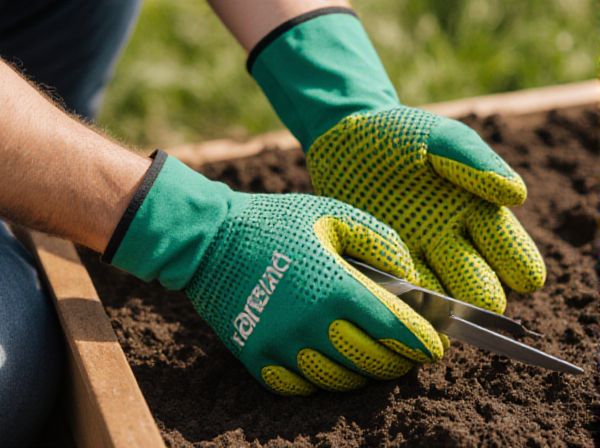
Cut-and-come-again harvesting vs Single harvest Illustration
Cut-and-come-again harvesting allows for multiple yields from the same plant by selectively harvesting mature leaves, promoting continuous growth and extended productivity. Single harvest involves collecting the entire crop at once, which usually results in a one-time yield but can be more efficient for certain plant types and large-scale operations. Choosing between these methods depends on crop type, desired harvest frequency, and overall yield goals.
Table of Comparison
| Aspect | Cut-and-Come-Again Harvesting | Single Harvest |
|---|---|---|
| Definition | Repeated harvesting by cutting parts of the plant while it regrows. | Harvesting the entire crop at once, ending the growth cycle. |
| Harvest Frequency | Multiple times over a growing season. | One time per crop cycle. |
| Yield Efficiency | Higher cumulative yield from the same plant over time. | Single yield per planting. |
| Crop Examples | Lettuce, spinach, herbs like basil and mint. | Root vegetables, grains, fruits like potatoes, wheat, tomatoes. |
| Plant Stress | Lower, encourages regrowth. | Higher, plants are uprooted or fully harvested. |
| Management | Requires regular monitoring and cutting. | Less frequent, one-time harvesting labor. |
| Crop Longevity | Extended through regrowth cycles. | Limited to one growth cycle per planting. |
Understanding Cut-and-Come-Again Harvesting
Cut-and-come-again harvesting involves selectively trimming only the outer leaves or parts of edible plants, allowing the inner growth to continue and produce subsequent harvests. This method increases yield over time by promoting continuous plant growth, particularly in leafy greens like lettuce, spinach, and herbs. Compared to single harvest techniques, which remove the entire plant at once, cut-and-come-again maximizes edible biomass and extends the harvesting period.
What is Single Harvest Gardening?
Single harvest gardening involves growing crops that are planted, cultivated, and harvested once within a season, yielding a single, large crop at maturity. This method is ideal for crops like corn, carrots, and root vegetables, which reach peak quality at one harvest time. Compared to cut-and-come-again harvesting, single harvest gardening requires less frequent maintenance but results in a one-time yield per planting cycle.
Top Edible Plants for Cut-and-Come-Again Harvest
Cut-and-come-again harvesting maximizes yield by allowing multiple harvests from top edible plants like lettuce, spinach, kale, and Swiss chard, which regenerate leaves quickly after cutting. Unlike single harvest crops such as carrots or pumpkins, these leafy greens provide continuous fresh produce over an extended growing season. This method enhances garden productivity and promotes sustainable, nutrient-rich food sources for home gardeners and commercial growers.
Single Harvest Crops: Best Choices for Beginners
Single harvest crops are ideal for beginner gardeners due to their simple growing and harvesting process, requiring less maintenance compared to cut-and-come-again varieties. Popular single harvest choices include root vegetables like carrots and beets, as well as fruiting crops such as tomatoes and cucumbers, which mature all at once for an easy picking experience. These crops minimize the need for repeated harvesting efforts, making them a straightforward option for those new to edible gardening.
Key Benefits of Cut-and-Come-Again Methods
Cut-and-come-again harvesting maximizes yield by allowing continuous plant regrowth, resulting in multiple harvests from a single sowing cycle. This method enhances plant health and extends the productive life of crops like leafy greens and herbs compared to single harvest techniques. Efficient resource use and steady supply of fresh produce characterize the key benefits of cut-and-come-again practices.
Pros and Cons of Single Harvest Techniques
Single harvest techniques allow for a concentrated yield of crops, ideal for plants like grains or root vegetables that mature simultaneously, ensuring uniformity in quality and easier mechanization. However, this method can lead to a shorter harvesting window, risking crop loss if adverse weather occurs and lacking the continuous supply advantage found in cut-and-come-again harvesting. The approach demands precise timing and labor intensity during peak seasons, potentially limiting flexibility in market availability and increasing post-harvest storage requirements.
Productivity Comparison: Ongoing vs. One-Time Harvest
Cut-and-come-again harvesting significantly boosts productivity by allowing multiple yield cycles from the same planting, maximizing output over time. Single harvest methods provide a one-time bulk yield but limit total production potential due to the absence of regrowth. Continuous harvesting strategies reduce waste and enhance resource efficiency compared to one-time harvests.
Garden Planning: Mixing Cut-and-Come-Again and Single Harvest Crops
In garden planning, combining cut-and-come-again crops like lettuce and spinach with single harvest vegetables such as tomatoes maximizes space efficiency and extends the harvest season. Cut-and-come-again crops provide continuous yields by encouraging regrowth after partial harvesting, while single harvest crops offer large, one-time bounties. Strategic placement and timing of these crop types enhance productivity and ensure a steady supply of fresh edible produce throughout the growing cycle.
Sustainability and Resource Use in Both Methods
Cut-and-come-again harvesting enhances sustainability by allowing multiple yields from the same plants, reducing the need for frequent replanting and conserving soil nutrients. This method optimizes resource use by minimizing water and fertilizer inputs over time compared to single harvests, which demand comprehensive resource investment for one-time crop production. Maintaining soil structure and biodiversity is more effective with cut-and-come-again practices, supporting long-term agricultural resilience.
Which Harvesting Style Suits Your Garden Best?
Cut-and-come-again harvesting allows gardeners to enjoy multiple yields from leafy greens and herbs by selectively picking outer leaves, promoting continuous growth and saving space. Single harvest crops like root vegetables or mature fruits require waiting until full maturity before harvesting but often produce larger, concentrated yields. Choosing between these harvesting styles depends on garden size, crop type, and desired harvest frequency, with cut-and-come-again ideal for small spaces and steady supply, while single harvest suits larger plots aiming for bulk produce.
Cut-and-come-again harvesting vs Single harvest Infographic

 gardendif.com
gardendif.com